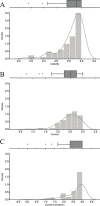A pilot study of patient satisfaction with a self-completed tablet-based digital questionnaire for collecting the patient's medical history in an emergency department
- PMID: 34330279
- PMCID: PMC8323085
- DOI: 10.1186/s12913-021-06748-y
A pilot study of patient satisfaction with a self-completed tablet-based digital questionnaire for collecting the patient's medical history in an emergency department
Abstract
Background: The increasing popularity and availability of tablet computers raises questions regarding clinical scenarios. This pilot study examined the patient's satisfaction when using a tablet-based digital questionnaire as a tool for obtaining medical history in an emergency department and to what extent gender, age, technical competence and mother tongue influence the user satisfaction. Patients were asked to complete three consecutive questionnaires: The first questionnaire collected basic epidemiological data to measure past digital usage behaviour, the second questionnaire collected the patient's medical history, and the third questionnaire assessed the overall perceived user satisfaction when using the tablet-based survey application for medical anamnesis.
Results: Of 111 consenting patients, 86 completed all three questionnaires. In summary, the user evaluation was positive with 97.7% (n = 84) of the patients stating that they had no major difficulties using the digital questionnaire. Only 8.1% (n = 7) of patients reported a preference to fill out a paper-and-pen version on the next visit instead, while 98.8% (n = 85) stated that they would feel confident filling out a digital questionnaire on the next visit. The variables gender, age, mother tongue and/or technical competence did not exert a statistically significant influence towards the defined scales usability, content and overall impression.
Conclusion: In conclusion, self-administered tablet-based questionnaires are widely accepted tools for collecting medical information in the emergency room across all ages and genders, regardless of technical competence.
Keywords: Anamnesis; Computerized questionnaires; self-anamnesis; Patient-conducted computer interview; Patient-reported outcome; Self-administered questionnaires; Self-assessment; Survey; Tablet; Tablet computers.
© 2021. The Author(s).
Conflict of interest statement
J.R. Schaefer (JRS) is co-editor of the journal “Der Internist” and author of several specialist and non-fiction books. JRS is an endowed professor of the Dr. R. Pohl Foundation and a physician at the University Hospital Marburg. JRS is active in the field of atherosclerosis prevention and SARS-CoV-2 control as a consultant to Sanofi-Genzyme, Amgen and B. Braun Melsungen and has received speaking fees from Synlab Academy, Berlin Chemie, Novo Nordisk, Novartis, MSD and Pfizer. JRS has received scientific funding from the Dr. R. Pohl Foundation and the Rhön Klinikum AG Foundation for Excellence in Medicine.
The other authors do not have any Competing Interest.
Figures


References
MeSH terms
LinkOut - more resources
Full Text Sources
Miscellaneous

